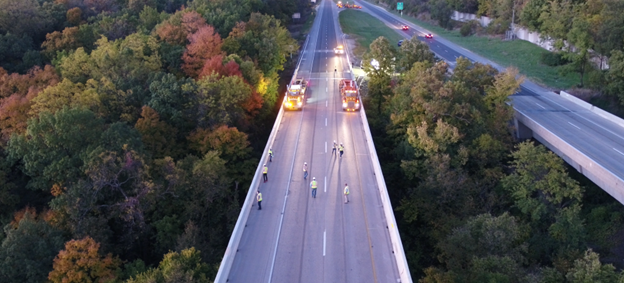Illinois Department of Transportation (IDOT)
Illinois Department of Transportation (IDOT) District 2
Structural Engineering Services: In-Depth Inspection, Installation of Sensors, Load Testing and Structural Evaluation
Rockford, IL
2019-2023
I-39 over Kishwaukee River
The twin structures spanning over the Kishwaukee River carrying route I-39 near Rockford Illinois have gained a great deal of notoriety since their construction in 1979 and 1980. There has been a vast amount of research and various independent studies published over 40 years focusing on the design, construction, and, primarily, the shear cracking of the girder webs directly following construction.
The existing structures S.N. 101-0133 (NB) & S.N. 101-0134 (SB) carry Interstate I-39 over the Kishwaukee River south of Rockford, Illinois. These twin bridges consist of five continuous spans, comprised of 156 single-cell precast, post-tensioned segmental concrete box segments with a single shear key at each web. The superstructure has three interior spans of 250’-0” and two end spans of 170’-0” totaling 1,190’-0” center-to-center abutment bearings. The roadway consists of two 12’-0” traffic lanes, an 8’-0” interior shoulder, and a 10’-0” exterior shoulder for an overall out-to-out width of 42’-0”.
The structures are of the “first generation” of post-tensioned precast concrete segmental bridges (PCSB) with segments erected by means of a launching truss and balanced cantilever construction. They were the first bridges of their kind built in Illinois and the first constructed by means of a launching truss in the United States.
HBM was retained by the Illinois Department of Transportation (IDOT) District 2 to perform a multi-phase physical and analytical structural evaluation of the northbound and southbound bridges. The overall objective of the project was to assess structures in an effort to extinguish any remaining uncertainties about the structural health and performance of these bridges by means of in-depth inspection, analytical modeling, instrumentation, and static load testing.
The final objective of the project was to instrument the bridges with vibrating wire strain gauges, crack meters, LVDT deflection monitoring systems as well as fiber optics to evaluate the structure’s capacity during static load testing. Vibration-based testing was also performed on external post-tensioning to evaluate the effective stresses in the tendons.
HBM’s Scope:
- In-depth NBIS-level Inspection
- Non-Destructive Testing (NDT) of Superstructure Concrete, Existing Internal Post-Tensioned Bars, and External Post-Tensioning
- Installation of Optical Fiber System with distributed sensors
- Load testing the structures using 2 sets of 4 trucks.
- Structural Evaluation (FEM) Analysis of the Structures based on the data received from the sensors based on the load testing
- Development of a Load Rating Tool for Evaluation of Overweight Permit Vehicles.
- Bridge Condition Report

To reach this objective several phases/tasks had to be performed prior to testing:
- In-depth NBIS level inspection of both structures as well as non-destructive testing of superstructure concrete, existing internal post-tensioned bars and external post-tensioning.
- Analytical, time dependent, stage constructed modeling using 3D finite element software to develop a baseline for static load testing and to update the current load rating. The models are used to design load tests and compare theoretical results vs the data collected during load tests. Develop an instrumentation plan and establish where each sensor is to be placed and which tests to be performed.
- Implement a load testing itinerary and sequence of vehicle positions at which data can be collected on various aspects of the bridge behavior. This also includes procuring multiple testing vehicles weighing upwards of 150,000 lbs.
- Perform load tests, collect strain data and compare with analytical models to calibrate the load rating and evaluate the in-service capacity of the bridges.
- Developed a rating tool for these structures to use for overweight permit vehicles. The tool incorporates all analytical and physical load testing results to provide the most accurate and current bridge response.












